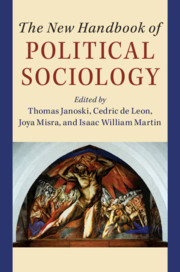Book contents
- The New Handbook of Political Sociology
- The New Handbook of Political Sociology
- Copyright page
- Dedication
- Contents
- Tables
- Figures
- Contributors
- Acknowledgments
- Introduction
- I Theories of Political Sociology
- II Media Explosion, Knowledge as Power, and Demographic Reversals
- 10 “Old” Media, “New” Media, Hybrid Media, and the Changing Character of Political Participation
- 11 The Sociology of Official Information Gathering
- 12 The Dark and Light Sides of Big Data
- 13 States, Parties, and Expertise
- 14 Toward a Political Sociology of Demography
- III The State and Its Political Organizations
- IV Civil Society: The Roots and Processes of Political Action
- V Established and New State Policies and Innovations
- VI Globalization and New and Bigger Sources of Power and Resistance
- Index
- References
10 - “Old” Media, “New” Media, Hybrid Media, and the Changing Character of Political Participation
from II - Media Explosion, Knowledge as Power, and Demographic Reversals
Published online by Cambridge University Press: 22 February 2020
- The New Handbook of Political Sociology
- The New Handbook of Political Sociology
- Copyright page
- Dedication
- Contents
- Tables
- Figures
- Contributors
- Acknowledgments
- Introduction
- I Theories of Political Sociology
- II Media Explosion, Knowledge as Power, and Demographic Reversals
- 10 “Old” Media, “New” Media, Hybrid Media, and the Changing Character of Political Participation
- 11 The Sociology of Official Information Gathering
- 12 The Dark and Light Sides of Big Data
- 13 States, Parties, and Expertise
- 14 Toward a Political Sociology of Demography
- III The State and Its Political Organizations
- IV Civil Society: The Roots and Processes of Political Action
- V Established and New State Policies and Innovations
- VI Globalization and New and Bigger Sources of Power and Resistance
- Index
- References
Summary
What is the role of media, especially the news media, in influencing citizens’ political beliefs, values, and political or civic action?
Clearly, many people for several hundred years have believed the media to be powerful agents of political persuasion and instruments of political action. In the early United States, both George Washington and Thomas Jefferson wrote scathingly of the press because they thought it caused harm to government (Schudson 1998). In Europe as in North America, individuals founded news organizations to influence political outcomes.
- Type
- Chapter
- Information
- The New Handbook of Political Sociology , pp. 269 - 289Publisher: Cambridge University PressPrint publication year: 2020
References
- 1
- Cited by

